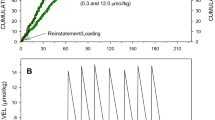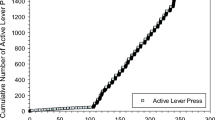Abstract
Rationale
A fundamental problem in the study of drugs as reinforcers is the evaluation of a drug's relative reinforcing effects and changes in such effects. Relative reinforcing effects can be measured by determining the preference for one drug dose relative to another drug dose. However, in IV drug self-administration studies technical limitations make direct comparisons between drug doses difficult. An alternative procedure is to measure the relative persistence of behavior across increases in schedule size.
Objective
To develop a more rapid method to measure the relative persistence of behavior. Instead of increasing the schedule size across sessions, schedule size was increased within sessions by use of a progressive-ratio schedule (PR).
Methods
Male rhesus monkeys orally self-administered ethanol during daily 3-h sessions. At each concentration responding was measured with fixed-ratio (FR) 8 schedules to obtain baseline values. Subsequently behavior was studied with a PR schedule. Relative persistence of behavior was calculated by dividing the mean response rate under the PR schedule by the mean response rate under the FR8 schedules. To compare these findings with results of choice between concentrations, monkeys were given concurrent access to pairs of ethanol concentrations.
Results
The relative persistence of behavior increased with increases in drug concentration. When two concentrations were concurrently available, the higher concentration maintained higher response rates.
Conclusions
The relative persistence of behavior can be efficiently measured by dividing the response rate under the PR schedule by the response rate under the FR schedule. Measures of relative persistence corresponded well with measures of choice and show that relative reinforcing effects increase as dose increases.




Similar content being viewed by others
References
Arnold JM, Roberts DCS (1997) A critique of fixed and progressive ratio schedules used to examine the neural substrates of drug reinforcement. Pharmacol Biochem Behav 57:441–447
Bickel WK, DeGrandpre RJ, Higgins ST (1993) Behavioral economics: a novel experimental approach to the study of drug dependence. Drug Alcohol Depend 33:173–192
Carroll ME (1987) Concurrent access to two concentrations of orally delivered phencyclidine: effects of feeding conditions. J Exp Anal Behav 47:347–362
Carroll ME, Meisch RA (1984) Increased drug-reinforced behavior due to food deprivation. In: Thompson T, Dews PB, Barrett JE (eds) Advances in behavioral pharmacology, vol 4. Academic Press, Orlando, pp 47–88
Carroll ME, Carmona GN, May SA (1991) Modifying drug-reinforced behavior by altering the economic conditions of the drug and a nondrug reinforcer. J Exp Anal Behav 56:361–376
Comer SD, Hunt VR, Carroll ME (1994) Effects of concurrent saccharin availability and buprenorphine pretreatment on demand for smoked cocaine base in rhesus monkeys. Psychopharmacology 115:15–23
Findley JD, Robinson WW, Peregrino L (1972) Addiction to secobarbital and chlordiazepoxide in the rhesus monkey by means of a self-infusion preference procedure. Psychopharmacologia 26:93–114
Gieske D (1978) Integrated drinking device for monkeys. Reports from the Research Laboratories of the Department of Psychiatry, University of Minnesota, Minneapolis, MN (PR-78-1)
Henningfield JE, Meisch RA (1976) Drinking device for rhesus monkeys. Pharmacol Biochem Behav 4:609–610
Henningfield JE, Meisch RA (1979) Ethanol drinking by rhesus monkeys with concurrent access to water. Pharmacol Biochem Behav 10:777–782
Hursh SR, Winger G (1995) Normalized demand for drugs and other reinforcers. J Exp Anal Behav 64:373–384
Iglauer C, Woods JH (1974) Concurrent performances: reinforcement by different doses of intravenous cocaine in rhesus monkeys. J Exp Anal Behav 22:179–196
Iglauer C, Llewellyn ME, Woods JH (1975) Concurrent schedules of cocaine injection in rhesus monkeys: dose variations under independent and non-independent variable-interval procedures. Pharmacol Rev 27:367–383
Institute of Laboratory Animal Resources, Commission on Life Sciences, National Research Council (1996) Guide for the Care and Use of Laboratory Animals. National Academy Press, Washington, D.C.
Johanson CE, Schuster CR (1975) A choice procedure for drug reinforcers: cocaine and methylphenidate in the rhesus monkey. J Pharmacol Exp Ther 193:676–688
Lemaire GA, Meisch RA (1984) Pentobarbital self-administration in rhesus monkeys: drug concentration and fixed-ratio size interactions. J Exp Anal Behav 42:37–49
Lemaire GA, Meisch RA (1985) Oral drug self-administration in rhesus monkeys: interactions between drug amount and fixed-ratio size. J Exp Anal Behav 44:377–389
Manzardo AM, Del Rio JA, Stein L, Belluzzi JD (2001) Rats choose cocaine over dopamine agonists in a two-lever self-administration preference test. Pharmacol Biochem Behav 70:257–265
Manzardo AM, Stein L, Belluzzi JD (2002) Rats prefer cocaine over nicotine in a two-lever self-administration choice test. Brain Res 924:10–19
Masoro EJ (1985) Nutrition and aging—a critical review. J Nutr 115:842–848
Meisch RA (2000) Relative persistence of behavior: a fundamental measure of relative reinforcing effects. Exp Clin Psychopharmacol 8:333–349
Meisch RA, Lemaire GA (1988) Oral self-administration of pentobarbital by rhesus monkeys: relative reinforcing effects under concurrent fixed-ratio schedules. J Exp Anal Behav 50:75–86
Meisch RA, Lemaire GA (1989) Oral self-administration of pentobarbital by rhesus monkeys: maintenance of behavior by different concurrently available volumes of drug solution. J Exp Anal Behav 52:111–126
Meisch RA, Spiga R (1998) Matching under nonindependent variable-ratio schedules of drug reinforcement. J Exp Anal Behav 70:23–34
Meisch RA, Stewart RB (1995) Relative reinforcing effects of different doses of orally delivered cocaine. Drug Alcohol Depend 37:141–147
Meisch RA, Lemaire GA, Cutrell EB (1992) Oral self-administration of pentobarbital by rhesus monkeys: relative reinforcing effects under concurrent signalled differential-reinforcement-of-low-rates schedules. Drug Alcohol Depend 30:215–225
Meisch RM, Stewart RS, Wang N-S (1996) Orally delivered methadone as a reinforcer for rhesus monkeys: the relation between drug concentration and choice. Pharmacol Biochem Behav 54:547–554
Pugh TD, Klopp RG, Weindruch R (1999) Controlling caloric consumption protocols for rodents and rhesus monkeys. Neurobiol Aging 20:157–165
Rowlett JK (2000) A labor-supply analysis of cocaine self-administration under progressive-ratio schedules: antecedents, methodologies, and perspectives. Psychopharmacology 153:1–16
Stafford D, LeSage MG, Glowa JR (1998) Progressive-ratio schedules of drug delivery in the analysis of drug self-administration: a review. Psychopharmacology 139:169–184
Stewart RB, Wang N-S, Bass AA, Meisch RA (2002) Relative reinforcing effects of different oral ethanol doses in rhesus monkeys. J Exp Anal Behav 77:49–64
Woolverton WL, Johanson CE (1984) Preference in rhesus monkeys given a choice between cocaine and d,l-cathinone. J Exp Anal Behav 41:35–43
Acknowledgements
This study was supported by NIAAA grant AA 10498 and NIDA grant DA 08913. Richard A. Meisch is the recipient of a NIDA Research Scientist Award (DA 00159). We thank Mr. Oscar Brown for his professional animal care.
Author information
Authors and Affiliations
Corresponding author
Rights and permissions
About this article
Cite this article
Gomez, T.H., Meisch, R.A. Relation between choice of ethanol concentration and response rates under progressive- and fixed-ratio schedules: studies with rhesus monkeys. Psychopharmacology 170, 1–8 (2003). https://doi.org/10.1007/s00213-003-1489-8
Received:
Accepted:
Published:
Issue Date:
DOI: https://doi.org/10.1007/s00213-003-1489-8




